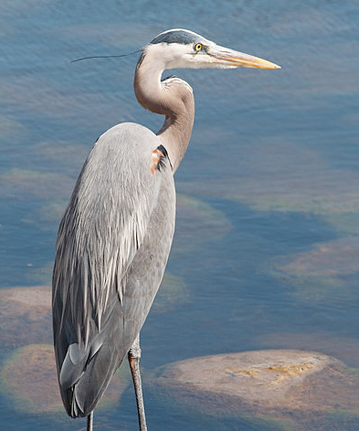Birds 104 Chapter 1
The Major Culprits, Great Blue and Great White Herons and Great Egrets
There are very few creatures on this continent that can impact the backyard pond more drastically than our largest wading birds, the Great Heron, in both its Blue and White forms, and the Great Egret. The Great Heron Ardea herodias (literally “heron heron” in Latin and Greek), 48” tall with a six-foot wingspan, might rightly be welcomed as one of the largest and most attractive shore birds on the planet, White or Grey, if it weren’t for its voracious appetite. An exquisitely adapted carnivore with a taste for sushi, Great Blue and Great White Herons will kill any and all aquatic animals they can spear with their deadly sharp bills, even large fish that are too big for them to swallow whole, and once they arrive at a likely site, they stay until there’s nothing left to hunt. Great Egrets Ardea modesta are slightly smaller than their big cousins, at “only” 39” tall, with a 51” wingspan, but are just as devastating.

By Dori (Own work) [GFDL or CC-BY-SA-3.0-us],via Wikimedia Commons
There is very little you can legally do to discourage these wading juggernauts from completely annihilating the fish in your pond once they get in, and with an extensive range throughout North America and major flyways on the East Coast and the Central US, there are very few places safe from their predation. Just to add insult to injury, as they wipe out your pond, they leave behind enormous droppings to remind you of what once was and is now no more, a messy, odiferous ‘thank you’ for your generosity.
Protected by the Migratory Bird Treaty Act, Great Blue Herons cannot legally be harmed no matter what the provocation, but they can be thwarted by proper pond design. Herons prefer to hunt while wading in shallow water, 4 to 12 inches deep, their long legs and necks providing the height and perspective needed to accurately target their prey. In deeper water, they don’t have the height advantage they need. So, most experienced water feature contractors go “steep and deep” in Heron infested areas. Keeping the sides vertical down to a flat shelf 18” deep all the way around, without any shallows or islands to allow easy access into the pond, will make it very tough for a Heron to get in and feed on your prize fish. They aren’t particularly comfortable hunting from far above the water surface either, even with those long necks. Since it’s not as easy for them to strike below the level of their feet, setting the rockwork around the pond well above water level will keep them from using their long necks while crouching. Faced with these difficulties, herons will simply move on to someone else’s backyard pond, one that provides easier access to prey.
There are very few creatures on this continent that can impact the backyard pond more drastically than our largest wading birds, the Great Heron, in both its Blue and White forms, and the Great Egret. The Great Heron Ardea herodias (literally “heron heron” in Latin and Greek), 48” tall with a six-foot wingspan, might rightly be welcomed as one of the largest and most attractive shore birds on the planet, White or Grey, if it weren’t for its voracious appetite. An exquisitely adapted carnivore with a taste for sushi, Great Blue and Great White Herons will kill any and all aquatic animals they can spear with their deadly sharp bills, even large fish that are too big for them to swallow whole, and once they arrive at a likely site, they stay until there’s nothing left to hunt. Great Egrets Ardea modesta are slightly smaller than their big cousins, at “only” 39” tall, with a 51” wingspan, but are just as devastating.

By Dori (Own work) [GFDL or CC-BY-SA-3.0-us],via Wikimedia Commons
There is very little you can legally do to discourage these wading juggernauts from completely annihilating the fish in your pond once they get in, and with an extensive range throughout North America and major flyways on the East Coast and the Central US, there are very few places safe from their predation. Just to add insult to injury, as they wipe out your pond, they leave behind enormous droppings to remind you of what once was and is now no more, a messy, odiferous ‘thank you’ for your generosity.
Protected by the Migratory Bird Treaty Act, Great Blue Herons cannot legally be harmed no matter what the provocation, but they can be thwarted by proper pond design. Herons prefer to hunt while wading in shallow water, 4 to 12 inches deep, their long legs and necks providing the height and perspective needed to accurately target their prey. In deeper water, they don’t have the height advantage they need. So, most experienced water feature contractors go “steep and deep” in Heron infested areas. Keeping the sides vertical down to a flat shelf 18” deep all the way around, without any shallows or islands to allow easy access into the pond, will make it very tough for a Heron to get in and feed on your prize fish. They aren’t particularly comfortable hunting from far above the water surface either, even with those long necks. Since it’s not as easy for them to strike below the level of their feet, setting the rockwork around the pond well above water level will keep them from using their long necks while crouching. Faced with these difficulties, herons will simply move on to someone else’s backyard pond, one that provides easier access to prey.




